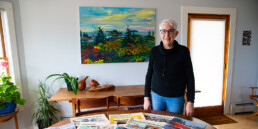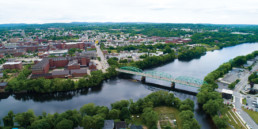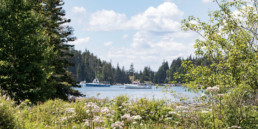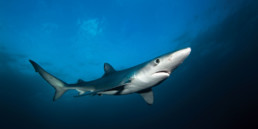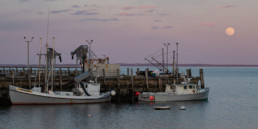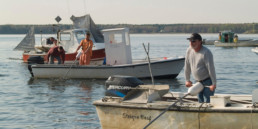Song of the Samsingers
How a Danish island is harmonizing renewable energy to redefine its future
STORY AND PHOTOS BY BROOKS WINNER
Landing on Samsø Island, part of Denmark, we were greeted by a kind of rock star.
“Hello! My name is Søren,” exclaimed the man. “I am the lead singer of the Samsingers,” he smiled, echoing a local pun (the residents of the island are known as “Samsingers”). Søren Hermansen was our host and tour guide, and though he doesn’t play or sing in a band, he is indeed a rock star, traveling the world as a spokesman for community energy projects, telling the story of how Samsø, his hometown, is building its own sustainable energy future.
Over the last decade, the Danish island of Samsø has become a beacon of sustainability throughout Europe and beyond. Remarkably, with a mix of community and privately owned wind farms (on land and offshore), straw-fired heating plants, electric vehicles, and solar panels, Samsø now produces more energy from renewables than it consumes, making it one of the first carbon-negative communities in the world.
In September 2014, five Maine islanders traveled to Samsø to learn how the community became world-renowned as an example of such smart energy development. The islanders were Marian Chioffi of Monhegan, Nate Johnson of Long Island in Casco Bay, Tom McAloon of Swan’s Island, Sam Saltonstall of Peaks Island, and Patrick Trainor of Vinalhaven. They were joined by 18 students and faculty from Bar Harbor’s College of the Atlantic and two representatives from the Island Institute’s Community Energy Program (myself included).
All are participants in the Collaborative for Island Energy Research and Action, or CIERA, a new partnership between the college and the Island Institute, supported by the Fund for Maine Islands. Over the course of our two-week visit, we explored the island, meeting the people who are leading this energy revolution and making it Denmark’s “renewable energy island.”
The Maine delegation was there to listen and learn from Hermansen and his colleagues. Our group was different from many that visit because we had two weeks on the island, much more time to explore than most who come for a day or two, and because we planned to use the knowledge we’d gain to help shape energy initiatives when we returned home.
Because the stakes were high back home, they needed more than words of inspiration. They were looking for solid, practical insights.
While Samsingers are not especially well known for their musical skills, after a few days at the Energy Academy, we began to feel as if we were watching a well-choreographed song-and-dance routine. Søren’s stories about the process by which Samsø became Denmark’s model of sustainable energy were fine-tuned, funny, and engaging. The narrative that he and his colleagues had crafted was one of unity, optimism, and change.
But the Maine islanders were looking for more than that. They wanted to know how it had been done, and what they could bring home to apply on their own islands. They were looking for some best practices, new approaches, and fresh ideas. Instead, what they were hearing seemed to be a well-rehearsed story. Because the stakes were high back home, they needed more than words of inspiration. They were looking for solid, practical insights.
Maine’s island communities face significant challenges related to energy and climate change. For example, Monhegan residents pay upwards of $0.70 per kilowatt-hour, one of the highest electric rates in the country, a challenge that contributes to the high cost of living on the island. This has become one of the biggest threats to the island remaining a year-round community.
CIERA participants in an Energy Academy brainstorming session.
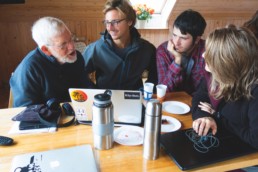
Swan’s Island Electric Cooperative has operated for more than a year with a volunteer general manager and no full-time line worker, struggling to maintain its aging infrastructure with declining revenues and one of the smallest memberships of any independent electric cooperative in the United States.
Adding to the challenges are disturbing signs of climate change—sea-level rise, increasingly powerful storms, acidifying oceans—all pressing issues for islanders who are, by nature and necessity, acutely aware of changes in their environment. Far more than a mere academic exercise, the trip to Denmark was an opportunity for the CIERA participants to soak up as much as they could, and to envision fruitful solutions for problems widely recognized in their communities.
After the first week of tours and introductory presentations, the islanders were champing at the bit, ready to find the good stuff. Here was a unique opportunity to take a multi-week master class with the sultan of sustainability. They were not about to waste it.
~
“Let me stop you there,” one of the Mainers interjected during a presentation about how businesses on Samsø had embraced the community’s energy-efficiency efforts. “This is a great story, but we want to know how this all happened. What were the incentives? What were the policies that made this possible? How did you sell this to the community?”
The presenter, one of Søren’s colleagues, looked a bit puzzled at the question. We were asking him to go deeper, to give us more than the quick show-and-tell that many who attend the Energy Academy get. We had time to investigate further and dissect the actual strategies and policies that Samsø has used to achieve such impressive results.
From there, the real exploration began. The Mainers asked tough questions. The Samsingers responded with direct, honest answers. As the CIERA participants traveled around the island, talking to as many people as they could in the remaining week, the gracious Danes welcomed them warmly into their homes and businesses.
Farmers who had invested in the wind project offered contrasting views. Some loved “their” turbines, while others expressed disappointment in the financial returns. Homeowners who had retrofitted their old island homes with thick insulation and energy-efficient electric heat pumps explained that the Danish government offered a special electric rate that made heat pumps a worthy successor to fossil-fuel systems.
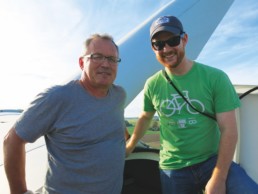
Søren Hermansen, left, with the author atop one of Samsø’s wind turbines.
The Mainers also met with a leader of the municipal government to hear about the island’s ambitious plans for rolling out electric vehicles across the island and replacing its diesel ferryboat with one powered by locally produced biogas.
When they quizzed Søren about specific incentives offered by the Danish government to promote renewable energy development, he explained that much of the $80 million spent to build the energy projects on Samsø came from subsidies or large corporate investments. Multinational oil and gas giant Royal Dutch Shell even chipped in for the offshore wind project.
By taking the time to dig into these crucial details, we got a better sense of what had worked, what hadn’t, and what was worth bringing back home. We had interrupted the song of the Samsingers, but in doing so we were able to more closely examine the instruments and the composition of the piece, allowing us to learn the best of what our maestros had to offer.
Since returning to their own islands, CIERA participants have started to digest the lessons learned from the trip and to integrate them into their own island energy projects. While each came away with something slightly different, there were important common themes that emerged.
Tom McAloon, the semiretired utility engineer from Swan’s Island, observes that despite the narrative about local engagement and investment, national incentives actually played a major part in setting the Samsingers up for success—even though those national incentives didn’t always work as intended.
“There may be clever ways to take the Danish example and leapfrog it,” he said, suggesting that Maine islands could learn from the challenges the Danes have faced as renewable energy pioneers.
McAloon has examined a menu of options for the Swan’s Island Electric Cooperative to consider as it looks for ways to continue to provide safe, reliable, and affordable electricity to its members. These options could include new technologies like electric vehicles or air-source heat pumps, but they could also include rethinking the way the cooperative operates. This “menu” is helping to inform discussions about the community’s energy future and how to address high energy costs on the island.
“I was most impressed by the community investment process and the model used by Samsingers to implement renewable energy projects,” said Nate Johnson, the Long Island native who works as an environmental engineer for one of the world’s leading tidal energy companies. Samsingers were allowed to buy shares of the wind turbines built on the island, a strategy that helped to build support for the project throughout the community.
As he investigates options for building a renewable energy demonstration project, Johnson plans to look for ways to engage his community through similar approaches. “There may not be a track record of energy projects on Long Island, but there is a basis for other community-led initiatives, like the effort to secede from Portland, which could provide a foundation for future projects,” he said.
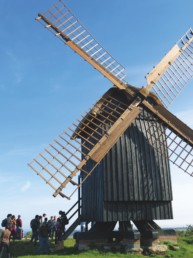
Perhaps the most valuable part of the trip for the Mainers, however, was the opportunity to connect with other islanders in a new and inspirational setting. When the CIERA participants get together, they share notes on everything from energy costs to entertainment.
“It was a wonderful experience to meet islanders from other Maine islands and Samsø,” said Patrick Trainor of Vinalhaven. “We shared stories of the higher cost of living on islands. We shared our love of island communities, the depth of our islands’ histories, and their stunning natural beauty.”
Given the space and time to explore shared energy challenges with their peers, the islanders could embrace new roles in shaping their islands’ energy futures and dare to dream big.
~
On our last day on the Danish island, after we had said most of our good-byes, we had one last meeting at the Energy Academy. A group of islanders from around Europe—members of the European Union’s “Smilegov” (smart multilevel governance) initiative—had converged on the island to discuss their plans to meet the EU’s ambitious goals for greenhouse gas reduction, renewable energy production, and energy efficiency. Søren invited us to join them.
While the Mainers could easily have felt overwhelmed by the group that included representatives from islands of over a million people and communities already implementing ambitious and innovative energy projects, instead, they felt right at home. All of them jumped right into the discussion, talking with government leaders from Malta, Cyprus, and the Orkney Islands of Scotland, sharing their experience and soaking up the insights from their European counterparts.
Later that afternoon, we said farvel (good-bye) to our hosts and hopped aboard the ferry to begin the journey back to Maine. Our two-week jam session with the leader of the Samsingers had ended, but the CIERA participants left with new ideas and new material, energized and ready to get to work creating their own energy masterpieces.
You can follow the progress of the CIERA project on the blog at http://fundformaineislands.org/category/ciera/.

